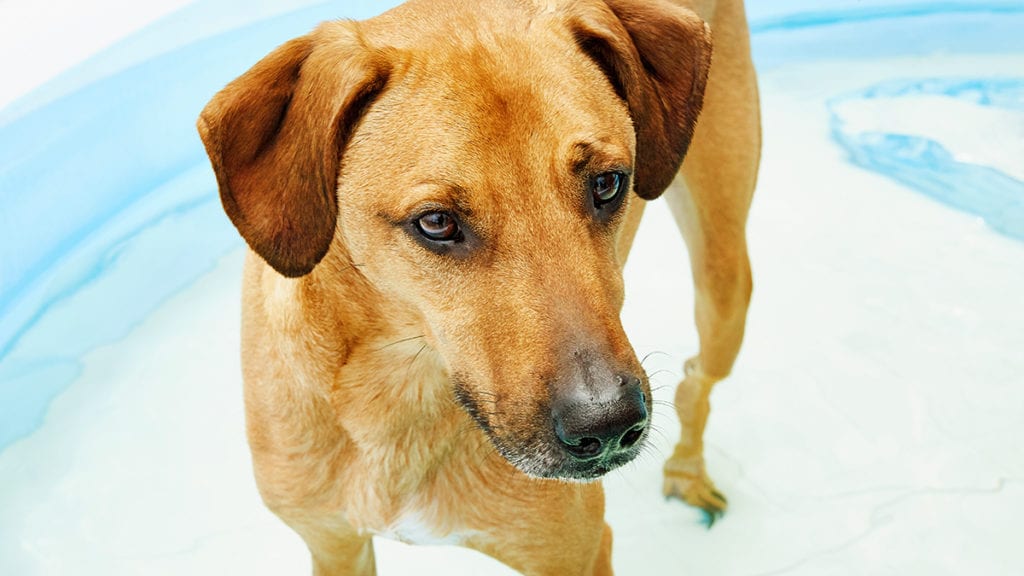Summer is here, and with temperatures reaching all-time highs, it is critical that pet parents understand the dangers of heatstroke in dogs, including signs to look for, how to treat heat stroke or heat exhaustion in dogs and, most importantly, the best ways to prevent this emergency from happening.
What is Heatstroke and Heat Exhaustion?
Heatstroke is a life-threatening condition caused by the body overheating—usually because of prolonged exposure to or physical exertion in high temperatures. Before heatstroke in dogs occurs, heat exhaustion happens. Heat exhaustion is a condition in which the core body temperature reaches above 103 degrees Fahrenheit.
When your pet’s core body temperature reaches 106 degrees Fahrenheit heatstroke occurs. Heatstroke causes the cells in the body to become damaged, which may result in organ failure. Heatstroke in dogs is more common than cats and can be life-threatening if not treated immediately.
What Causes Heatstroke in Dogs?
Unlike humans, pets have very few sweat glands and do little to regulate their body temperature. Pets cool down by panting, or rapid open-mouth breathing. When panting is not enough to cool your pet down in excessive heat or exertion, heatstroke may ensue.
What Are the Symptoms of Heatstroke in Dogs?
During the summer months—especially during the hottest parts of the day—it is important to monitor your pup for signs of heat stress. The earlier you detect and treat heatstroke, the better the prognosis. The following are clinical signs of heatstroke in dogs:
- Excessive and constant panting
- Dry and sticky gums (a sign of dehydration in a dog)
- Dark red gums (the normal color is light pink)
- Vomiting
- Not acting themselves—wobbly or walking drunk
- Increased heart rate
- Skin and hair feels obviously warm to the touch
- Bloody or dark black tarry diarrhea
- Seizures, if severe
- Collapse, if especially severe
- Difficulty breathing
If you note any of these clinical signs in your pet, move him to a shaded, cool area with accessible water and have your pet evaluated immediately by your veterinarian.
How to Diagnose Heatstroke or Heat Exhaustion in Dogs
Diagnosis of heatstroke in dogs is based on the pup’s history of heat exposure, current clinical signs and a core body temperature greater than 106 degrees Fahrenheit.
How to Treat Heatstroke in Dogs
Heatstroke is an emergency, so take your pet to the veterinarian right away. Your veterinarian will begin aggressive supportive treatment immediately. Treatment is based on your veterinarian’s evaluation of your pet’s condition and may include
- Hospitalization
- Bloodwork
- IV fluids
- Cooling measures—fan, cool towels on the paw pads
- Plasma transfusions, in severe cases
- Antibiotic infusions
- Anti-vomiting medications (if needed)
- Anti-seizure medications (if needed)
- Oxygen therapy
- 24-hour critical care monitoring for organ failure
Note: Heatstroke in dogs is a life-threating condition with a guarded prognosis, despite extreme measures and treatment.
Preventing Heatstroke and Heat Exhaustion in Dogs
By following a few simple tips, you can prevent heatstroke in dogs this summer.
- Before exercising your pet outside, confirm with your veterinarian that your dog is healthy enough.
- Make sure your dog has sufficient access to shade, water and a cool area when outside. Providing a dog water fountain is an easy way to both give your dog access to fresh water and encourage him to drink. You also can carry a water bottle for your pet.
- Choose cooler times of the day—such as early morning or evening—for walks and other outdoor activities.
- Know the clinical signs of overheating and be ready to act quickly.
- Never leave your dog in a car, even with open windows, unless the air-conditioning is running.
- Keep your pet cool this summer when he snoozes with cooling dog beds and elevated dog beds designed to keep him up off the warm ground.
Note: Brachycephalic dog breeds (those with a flat and wide skull shape, such as Bulldogs, Pekingese and Pugs) and overweight dogs are more prone to heat stroke. Take extra preventive measures for these dogs during hotter months.
If you have any questions or concerns about heatstroke and heat exhaustion in dogs, call or visit your veterinarian. They are your best resource to ensure the health and well-being of your pets.

Share:









